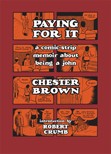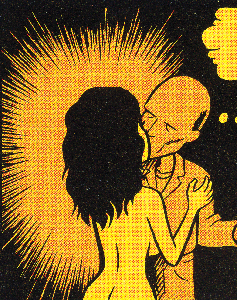Chester Brown is an award-winning cartoonist and a two-time Libertarian Party of Canada candidate, but these days it’s his life as a john that’s getting the most attention. In his recent autobiographical graphic novel, Paying For It, he tells us about the twenty-three prostitutes he has been with since deciding to pursue paid sex in 1999.
Brown believes that romantic relationships are nearly always a bad idea. “It’s the exclusive nature of the relationship: that one person is supposed to fulfill all of your needs and they’re supposed to be this centre of your emotional and sexual life. It just puts too much pressure on that one relationship. If it wasn’t a matter of you relying on that one person for everything, it would change the dynamic,” says Brown. This “possessive monogamy,” as he boils it down to later in the book, is what he believes to be the problem. “It should be more casual, the way that friendships are.”
The book opens with Brown’s breakup with his last girlfriend, Sook-Yin Lee (who was then a MuchMusic VJ). This first scene stands apart since it is almost entirely blacked out. “I tried to draw it several times and I couldn’t get the emotional tone right,” says Brown. “Particularly the facial expressions.” As he progressed with his drawings for the other scenes, he decided that it wasn’t necessary to draw the first one. “I was a little bit concerned because I thought maybe it would indicate a black mood inside of me, that I was tremendously emotionally hurt by this and that that’s what the blackness was supposed to convey,
which it wasn’t.”

Paying For It
Chester Brown
Drawn & Quarterly
$24.95
hardcover
272pp
9781770460485
Brown had reservations about the title of the book. “I wanted something more direct. My original title was ‘23 Prostitutes’ and they didn’t want the word prostitute in the title. That, for them, was too direct,” says Brown. In the end, he said that he was able to accept the title because of the way it might mislead the reader. “If they thought the title, Paying For It, was going to imply that I somehow feel contrite about all this or have regrets or feel like I’m paying for it in some non-monetary way, then that doesn’t happen at the end and your reader’s expectations would be dashed, I kinda like that. I guess that’s why I was able to accept the title in the end.”
His previous work, such as the acclaimed Louis Riel: A Comic-Strip Biography, carried the artistic influence of American cartoonist Harold Gray (the creator of Little Orphan Annie). But now Brown is using a more rigid look, one inspired by American cartoonist Fletcher Hanks (from the golden age of comic books). The barrelling, stocky bodies with small heads have been replaced with more stylized figures that have a limited range of facial expression, if any at all. (Of particular note is the absence of any faces for the prostitutes. They are either obscured by speech bubbles, out of frame, or the ladies are drawn with their backs to the viewer. The Foreword says Brown “altered aspects of their bodies if they could potentially reveal an identity.” But given that he already omits ethnicity and hair colour in some cases, it’s not clear that this was a necessary obfuscation, and it seems to disassociate the viewer from the women on a noticeable level.)
Another difference that Brown noticed between this book and Riel was the promo tour. “Well, I thought I was used to being interviewed and was fine in I actually handled the them. first few print interviews OK, but then I did my first broadcast radio about the book. I don’t know if you heard me on Jian Ghomeshi’s show.Yeah, it was horrible. I was stuttering and stammering and really nervous. I did lots of radio interviews and TV interviews for the Riel book and I was fine. It must have been the subject. I still, on some level, am feeling ashamed about the subject, about being a john and being open about it. That took me by surprise because I have always been open about it to friends and family, or at least close family, so I wasn’t aware. I thought I was over the sense of shame, but apparently I’m not.”
Brown depicts many of the conversations he had with his friends and family, particularly with Kris Nakamura and fellow cartoonists Seth and Joe Matt, about his new life as a john. He develops his views on prostitution in these scenes, but it’s in the twenty-three appendices and the notes section at the end of the book that he tackles a lot of the more specific issues surrounding prostitution. From self-esteem and human trafficking to taxation and licensing, he covers a lot of ground.
He also takes some very controversial stances on things like addiction (he backs Dr. Jeffrey A. Schaler’s position that addiction is a choice, not a disease) and the institution of marriage (which he thinks is evil). Despite this, Brown reports that the part of the book that’s getting most of the attention is his current sexual relationship, which comes up at the end. “Everyone is very interested and, of course, I write very little about her. I guess that fuels people’s curiosity.”
*SPOILER ALERT* (A bad thing to do in a book review, but, damn,
it’s just such an interesting part of this tale.)
At the end of the book, which wraps up at the beginning of 2004, Brown
enters into a monogamous relationship of sorts with a prostitute he calls Denise in the graphic novel, and he is still involved with her today. “It was a surprise for me too. When I began writing the book, I wrote a full script in 2006 and I knew it was going to take a little bit of time for me to draw it, so I wasn’t sure how things were going to go. Although I was already in the relationship with [Denise], I didn’t know how things would go. For all I knew we would be broken up by the time I finished drawing the book. Broken up – that we wouldn’t be having sex anymore. See, I’m using relationship or girlfriend/ boyfriend type language around her, but anyways. So, I left the ending open and things just happened the way things happened and I’m still involved with her.”
Paying For It is an uncommon look into the world of prostitution from a john’s perspective. It would be naïve to generalize from one man’s experience to the whole profession, but it does offer a counter to those who believe that sex work is full of nothing but violence and despair. His arguments for the decriminalization of prostitution form the most impassioned aspect of the book, and are fairly opportune given that the Ontario courts are getting ready to hear the government’s appeal of Justice Susan Himel’s ruling last year that struck down the province’s prostitution laws.
By contrast, there is very little passion found in the drawings. Coupled with the candid, and sometimes uncomfortable, moments that occur, Brown’s new Robert Bresson approach to art can leave you cold. It’s as though he removed from the visuals what he wants others to remove from their relationships: emotion. No matter what side of the sex work debate you find yourself on, you’re likely to find this book challenging on some level, which is probably the point. mRb







0 Comments